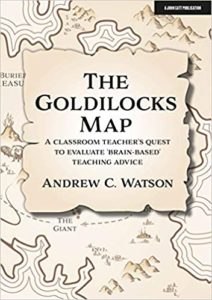
 The Goldilocks Map: A Classroom Teacher’s Quest to Evaluate ‘Brain-Based’ Teaching Advice is an entertaining and eye-opening conversation that seeks to help the reader develop a way of thinking that is sorely missing in today’s discourse around teaching and the brain. It is often stated that we need to be critical consumers of brain-based research as we apply it to the classroom; this book gives a roadmap showing us how. Andrew Watson takes us on this “quest” that reflects his 16 years of teaching experience and subsequent “Mind, Brain, Education” degree. The coaching in this book is an essential introduction for the developing teacher, the experienced teacher seeking to develop their understanding, as well as the experienced researcher who could always use a course in effective translation and writing. The experience Watson offers is delightful for all.
The Goldilocks Map: A Classroom Teacher’s Quest to Evaluate ‘Brain-Based’ Teaching Advice is an entertaining and eye-opening conversation that seeks to help the reader develop a way of thinking that is sorely missing in today’s discourse around teaching and the brain. It is often stated that we need to be critical consumers of brain-based research as we apply it to the classroom; this book gives a roadmap showing us how. Andrew Watson takes us on this “quest” that reflects his 16 years of teaching experience and subsequent “Mind, Brain, Education” degree. The coaching in this book is an essential introduction for the developing teacher, the experienced teacher seeking to develop their understanding, as well as the experienced researcher who could always use a course in effective translation and writing. The experience Watson offers is delightful for all.
Andrew Watson embeds this search for understanding of the Neuroscience and Psychology of education through a playful and humorous narrative. For some readers, embedding neuroscience in the quests of Aladdin, Goldilocks, and Middle Earth may be off-putting. But seriously, you need to relax a bit and enjoy. In fact, accepting this narrative style is an essential element in disarming our pretentious mindsets and allows one to approach this field with an authentic search for understanding and intellectual transparency while still embracing the simple joys of good storytelling.
The book is not an encyclopedic rehashing of implications of neuroscience for education, but it fills an important gap. Through a series of deep dives into themes such as environmental enrichment, spaced learning, and music in education, the reader is coached on how to locate, evaluate, and communicate research around these topics and more. As someone who regularly translates between neuroscience and education, I found the book refreshing and very useful.
One of the books greatest strengths is its attention to language use in research and translation. Watson highlights the word use and phrasing used by advocates for neuroeducation and calls our attention to some of the ridiculousness in original publications as well as our subsequent attempts to explain this research to colleagues. However, he does not diminish the research but elevates it by revealing the intention behind published words making the research more accessible. Without careful intention, we may catch ourselves and our peers exercising some common missteps by using language to obfuscate our lack of understanding or to add gravitas to otherwise empty phrases. I guarantee that you will humbly find your own words reflected in these pages and gain strategies to communicate more effectively.
Watson also is taking us on an active quest of discovery by not seeking our passive acceptance of research and application. Each chapter empowers the reader, as a member of the mind, brain, education community, to engage the community with a sense of exploration. Teachers are not simply consumers of research; the translation they enact brings to bear their expertise in acts of community involvement that make this research living. In my opinion, researchers are too often placed on pedestals and some researchers hide in their ivory towers of academia. Here we have the tools to pull this community together and flatten the illusion of a hierarchy.
There are also plenty of unanticipated “gems” in this book that will inspire you to take a moment to go on your own exploratory journey to accompany the pages. I found myself on many occasions pulling up a suggested web resource and learning something new or exploring an article I previously read out of pure curiosity inspired by these pages. I frequently jotted down particularly important turns of phrase and thought experiments that I could put to immediate use in my own scientific practice to not only make my work easier to understand for others but also to help make my own goals transparent to me.
This intellectual, entertaining, and often humorous engagement with the field is just what we all needed – useful as an introduction and useful to get us back on track.




